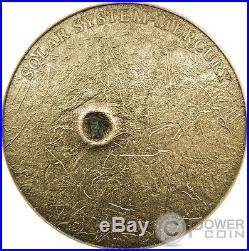Archive for May, 2016
1st May
2016





31.1 (1 oz). This beautiful 1 Oz Silver coin, with a real meteorite and yellow Antique Finsh quality, is the second issue of the series “Solar System”. The coin depicts the Mercury surface on both sides, with a concave shape and the insert is a real piece of the NWA 8409 Meteorite. The coin is housed in a prestigious wooden box with Certificate of Authenticity. Extremely low mintage of 686 pieces worldwide! The reverse of the coin depicts the Mercury surface, with very realistic details. What makes this coin unique is a real meteorite called NWA 8409, fallen on Earth in Northwest Africa, inlaid on the coin. On top of the coin the inscription “Solar System Mercury” and on the obverse side the effigy of Her Majesty Queen Elizabeth II. Mercury Mercury is the smallest planet in the Solar System and the one closest to the Sun, with an orbital period of about 88 Earth days, which is much faster than any other planet in the Solar System. Seen from Earth, it appears to move around its orbit in about 116 days. It has no known natural satellites. It is named after the Roman deity Mercury, the messenger to the gods. Partly because it has almost no atmosphere to retain heat, Mercury’s surface temperature varies diurnally more than any other planet in the Solar System, ranging from 100 K (-173 °C; -280 °F) at night to 700 K (427 °C; 800 °F) during the day in some equatorial regions. The poles are constantly below 180 K (-93 °C; -136 °F). Mercury’s axis has the smallest tilt of any of the Solar System’s planets (about 1/30 of a degree). However it has the largest orbital eccentricity: at aphelion, Mercury is about 1.5 times as far from the Sun as it is at perihelion. Mercury’s surface is heavily cratered and similar in appearance to the Moon, indicating that it has been geologically inactive for billions of years. Mercury is gravitationally locked and rotates in a way that is unique in the Solar System. As seen relative to the fixed stars, it rotates on its axis exactly three times for every two revolutions it makes around the Sun. As seen from the Sun, in a frame of reference that rotates with the orbital motion, it appears to rotate only once every two Mercurian years. An observer on Mercury would therefore see only one day every two years. The item “SOLAR SYSTEM MERCURY NWA 8409 Meteorite Silver Coin 1$ Niue 2016″ is in sale since Friday, April 29, 2016. This item is in the category “Coins & Paper Money\Coins\ World\Australia & Oceania\South Pacific”. The seller is “powercoin_italy” and is located in Roma. This item can be shipped worldwide.
- Circulated/Uncirculated: Uncirculated
- Year: 2016
- Composition: Silver
- Country/Region of Manufacture: Niue
Comments Off
1st May
2016







Extremely low Mintage limit, only 1,500 Sets!! Certificate of Authenticity + BOX. 12 Coins create one amazing Set!! One of the worlds most beloved Christmas carols, The Twelve Days of Christmas famously enumerates a series of increasingly grandiose gifts given on each of the twelve days of Christmas, ultimately leaving singers with 364-gifts from a true love. A cumulative song, each verse is built on top of the previous verses. It has been one of the most popular and oft-recorded Christmas songs in America and Europe throughout the past century. The Twelve Days of Christmas celebrates the period of merrymaking from the day after Christmas, December 26, to the Feast of the Epiphany, January 6, or, the Twelfth Day. Although the specific origins of the song are not known, it possibly began as a Twelfth Night memory-and-forfeits game, in which a leader recited a verse; each of the players repeated the verse; the leader added another verse, and so on, until one of the players made a mistake, with the player who erred paying an obligatory penalty, such as offering up a kiss or a sweet. This interpretation is substantiated within the earliest known printed version of the song in the childrens book Mirth without Mischief c. The song apparently is older than the printed version, though it is not known how much older. While the song is considered an English carol, textual evidence indicates that the song was not English in origin, but rather, French. Three French versions of the song are known. Halliwell reportedly first performed the song professionally in 1842. In the early 20th century, Frederic Austin wrote an arrangement that has since become standard. A bit of modern folklore claims that the songs lyrics were written as a catechism song to help young Catholics learn their faith at a time when practicing Catholicism was discouraged in England (1558 until 1829). However, there is no substantive evidence supporting this or similar claims, which in spite of a lack of historical data to support it, continues to proliferate since the advent of the Internet. Significantly, scholars point out that there exist no obvious relationships between the religious tenets to be memorized and the symbols used to represent them, and, there exists a great deal of variation in the list of tenets supposedly symbolized by the song. Interestingly, faith-based explanations of the song can be traced only as far back as the 1990s. Several scholars have hypothesized that the song may have been confused with, or borrows from, the format of another song, A New Dial, also known as In Those Twelve Days. Dating to at least 1625, A New Dial assigns religious meanings to each of the 12-days of Christmas, but not for the purpose of teaching a catechism. In a manner somewhat similar to the memory-and-forfeits performance of The Twelve Days of Christmas, A New Dial was recited in a question-and-answer format. And yet, around the world, The Twelve Days of Christmas is understood by most as a joyful song celebrating the Christmas season with imagery of gifts, dancing and music. In that regard, the songs likely origins in rural France take on greater significance when considering the fantastical nature of the gifts featured. Indeed, though historically enjoyed by all classes or segments of society, the carol may well have begun among poorer, agriculturally dependent classes of French society unable to afford expensive, store-bought gifts, with the tradition of exchanging gifts during Christmastime dating back at least as far as the 4th century. Coupled with the songs purported use as a memory-and-forfeits game (strongly supported by historical evidence via diaries and memoirs), the gifts of birds and of humans increasingly more active and merry with each verse take on enhanced meaning as representing extraordinary wealth and generosity out-of-reach for most of the populace. Considering European cultural traditions from medieval times through to the 19th century, the commonplace nature of the songs gifts offer modern eyes a unique window into the past, as each gift can be traced to centuries-old symbols of fertility or wealth. And so, The Twelve Days of Christmas remains to this day a beloved Christmastime classic a delightful celebration of love and merriment shared among family and friends. 9.7 Oz / 12x25g. Nice Authentic add to your collection. We are established and guarantee the authenticity of the products we sell. We have our inventory of precious metals bought only from reputable mints. Please consider your fair Feedback. Let us know if you need this overnight. We will do our best to accommodate your request. Fast shiiping will take 3-4 days(extra charge). For damaged items, please save all outside and inside packaging and wrapping for inspection by the Post Office. Return item must be sent within 14 days after it has been received. We will do our best to satisfy our customers. Fell free to contact if you have any questions. The item “Niue 2009 12×2$ Twelve Days of Christmas12x 25 gr Silver Proof Coin Set” is in sale since Thursday, April 21, 2016. This item is in the category “Coins & Paper Money\Coins\ World\Australia & Oceania\South Pacific”. The seller is “worldancient” and is located in Etobicoke, Ontario. This item can be shipped worldwide.
Comments Off

